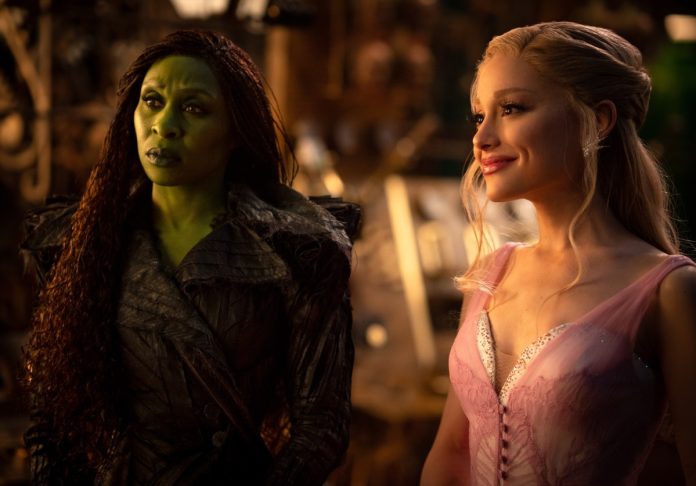
Last autumn, Jon M. Chu’s adaptation of “Wicked,” the long-celebrated stage musical based on Gregory Maguire’s novel, became a global phenomenon. Grossing over $750 million worldwide and winning two Academy Awards, it became one of the most celebrated movie musicals in recent memory. The catch? Chu’s 2024 Wicked adaptation only covered the Broadway show’s first act, tackling a lighter tone, featuring the show’s most “popular” tunes, and introduced audiences to his version of a world that many had dreamed of seeing on the big screen for decades. By splitting the film into two parts, Chu can’t rely on the inherent whimsy of the show’s first act and created a difficult challenge for himself, opting to stretch a one-hour, grim second act into a feature-length film. While several of Chu’s returning collaborators (namely Cynthia Erivo and Ariana Grande) still shine bright in the story’s second act, Wicked: For Good never finds its footing as its own complete film, failing to cast another spell.
The second part of Chu’s elongated exploration of the stage musical begins with a voiceover from Madame Morrible (a miscast Michelle Yeoh), who shares that it has been twelve tide turns since Elphaba (now dubbed The Wicked Witch of the West) escaped with the Grimmerie. Much like Act II of the stage show, it’s immediately clear that Wicked: For Good will have a much darker tone than its sparkling predecessor, as Madame Morrible spreads lies about Elphaba to Oz’s brainwashed citizens, who are willing and eager to believe all of the propaganda coming from those in power. While Elphaba lives in a hideout in the Ozian forest, fighting to expose The Wizard (Jeff Goldblum) and all of his lies, Glinda resides at the palace in the Emerald City, seemingly unaware that Madame Morrible and The Wizard are using her as a pawn in their mission to sow political discord. Despite her unlikely friendship with Elphaba in the first film, Glinda has embraced her role within the establishment as a glittery pink figurehead of goodness for all of Oz, comically noting that she should trademark the word “good.” Madame Morrible even gifts her with a new mode of transportation, her iconic pink bubble that she is instantly “obsessulated” with. It doesn’t matter that she’s incapable of Elphaba’s magic; Madame Morrible has built in a secret that will convince everyone in Oz that, as Glinda the Good, she’s just as powerful as Elphaba but incapable of her supposed wickedness.
In the first moments of the film, Chu and returning co-writers Winnie Holzman and Dana Fox focus on Glinda and begin their expansion of the character, incorporating a flashback to her childhood birthday party, where she tries to convince the other young partygoers that she can cast a spell with her magic wand. Nothing happens, of course, but her charisma and charm win out over her inability to perform magic. Often doing nothing more than stretching out the runtime and attempting to justify truncating the story into two parts, Wicked: For Good is padded with several flashbacks. This scene mostly works, though, in giving Glinda a parallel arc to Elphaba, as a similarly timed scene in Wicked gave viewers a deeper understanding of her childhood motivations and insecurities. Glinda is still relying on those formative tricks and is eager to use her new position in the Emerald City to lift everyone’s spirits. As Captain of the Gale Force, Fiyero (Jonathan Bailey), has a new role in the political shakeup, too, with his formerly carefree attitude replaced by a more stoic sense of duty to find Elphaba. Much to his surprise, he’s now engaged to Glinda, and their upcoming wedding is set to coincide perfectly with the opening of the Yellow Brick Road. According to Madame Morrible, it’s good for their fellow Ozians to have something to look forward to in a time of such turmoil.
While the screenwriters’ additions to Glinda’s story feel like clunky integrations of backstory without much nuance, Grande elevates the character above the narrative stumbles. This is immediately clear in the film’s first musical number, “Thank Goodness,” where she blends the character’s confidence and doubt, her desire to win over her audience masking an underlying sadness. Something is needling her about Elphaba’s absence and their respective places in Madame Morrible’s good/wicked binary. Unfortunately, Yeoh doesn’t have the vocal chops to match Grande’s prowess, and their vocal contrast ultimately forces the film’s introduction to one of Act II’s catchiest songs to fall a bit flat. The additional moments with Glinda, where Grande is able to showcase her talent as a dramatic actress, developing her character’s inner sadness and emotional depth, are where Wicked: For Good works best. Grande also uses the effervescence and comedic charm that she brought to the first film to balance the darkness of the musical’s second act, something that has largely been missing from iterations of the stage show. Still, it’s impossible not to feel like she’s a bit let down by Chu’s direction and Stephen Schwartz’s lyrics to Glinda’s original ballad, “The Girl in the Bubble.” As she rhymes “bubble” with… “bubble” and floats through her palace quarters where Chu is seemingly unable to make up his mind on where to put the camera, it’s impossible not to imagine what Grande could’ve achieved with Vincente Minnelli or Stanley Donen behind the camera in a Golden Age Musical deserving of her talent.
As Glinda tries to keep the spirits of her fellow Ozians high, Elphaba makes her grand entrance in what feels like a showcase for the film’s visual effects instead of a purposeful introduction to one of its lead characters. For a movie based on a stage musical with practical effects inspired by one of the greatest cinematic Technicolor achievements, it’s disappointing to see Chu and company rely so heavily on CGI, with the inventions of the creative team blurred and washed out by cinematographer Alice Brooks’ dull color palette. The lighting here often reminded me of being in a poorly lit fitting room, as if Brooks inexplicably opted to highlight the film’s worst qualities, while obscuring some of her collaborators’ best inventions. Her style here isn’t a pivot from Wicked, of course, but as Wicked: For Good relies a bit more heavily on its CGI creations, the choices are a bit more obvious. And as Elphaba soars above animals laboring away on the construction of the Yellow Brick Road, it’s dizzying rather than awe-inspiring. In the forest, Elphaba notices that the animals (including beloved Dulcibear), feeling that their home is now rotten, have packed up to go to the land beyond Oz. In the second of the film’s two original songs, penned by Schwartz, “No Place Like Home,” she implores them to stay and fight alongside her in her quest to restore Oz. The song itself is a rather stiff ballad that acts as another heavy-handed reminder of the timeliness of the story’s political themes, which are repeated several times throughout the film. While this song isn’t nearly as memorable as those in the original musical, Erivo tackles it with a newfound power from the character. It’s pretty remarkable that she manages to keep this scene so grounded, especially as she doesn’t have a single human to play off of, instead acting alone opposite dozens of CGI woodland creatures.
By splitting the film into two parts, the sense of wonder surrounding some of the first film’s strongest technical elements has mostly dissipated, save for Paul Tazewell’s intricate, thoughtfully constructed costumes and Nathan Crowley’s detailed production design. Even some of the new additions not present in the stage musical, such as Glinda and Fiyero’s wedding, lack originality and recall the look and feel of Chu’s earlier hit, Crazy Rich Asians. It’s here that Chu gives credence to fans of the stage show who worried that the second act of the musical simply didn’t have enough material to justify its separation from the first part. Aside from Grande’s elevation of her character’s new material, most of what works in Wicked: For Good isn’t anything original, but what Chu directly carried over from the show’s second act: the existing musical numbers. Despite their lack of chemistry, Erivo especially shines opposite Bailey in “As Long as You’re Mine,” and she later delivers what may be the definitive version of “No Good Deed.” She’s a gifted, musical powerhouse who, despite the film’s flaws, creates musical moments that are bound to give viewers goosebumps. Goldblum has a few funny lines, but fares less well in “Wonderful,” opting for a Rex Harrison style of speak-singing that simply can’t compete with Joel Grey’s interpretation. The strongest number, though, is of course the titular track, “For Good.” Just as Erivo and Grande did with “Defying Gravity,” the pair channels the beauty and pain of Elphaba and Glinda’s friendship into an emotional and memorable grand finale.
While the songs in the musical’s second act certainly aren’t as memorable as the first, Wicked: For Good casts a wide net for its audience, appealing to everyone from fans of the stage show to families and children. But that doesn’t mean Chu shouldn’t trust that audience to put the pieces together. It’s expected for the second act of a musical to feature a small batch of reprises, but Chu takes this up a notch and acts as if viewers need constant reminders of the celebrated film they just saw last year. Alongside reprises from the musical (“No One Mourns the Wicked,” “I’m Not That Girl”), and a few new compositions, Chu recycles and incorporates clips from the first movie as flashbacks, stalling all momentum in the new narrative. The best reprises subtly remind viewers of the emotional complexities of the characters and how their lives may have changed as the story shifts. But by incorporating several flashbacks to the first film as if they were Easter eggs in a comic book movie, Chu negates the intended value of these pieces of music in favor of fan service.
That fan service is even more pronounced when it becomes clear that the filmmaking team is unsure of how to address the story’s connection to The Wizard of Oz. At first, this connection doesn’t stray far from the original musical, as Nessarose (Marissa Bode), now the Governor of Munchkinland, has put an order in place to prohibit travel for animals and munchkins in and out of Munchkinland. She has an ulterior motive, though, as she wants to prevent Boq (Ethan Slater) from leaving her to pursue Glinda. What should have been an opportunity for Chu, Holzman, and Fox to explore Nessarose’s fraught relationship with Elphaba and her complicated intent on oppressing others, instead feels like a bit of fanfiction simply to introduce his transformation into the Tin Man and to force the subsequent events that bring that little girl from Kansas all the way to Munchkinland. With the inclusion of Dorothy, the Scarecrow, the Tin Man, and the Cowardly Lion, Chu wants to have his cake and eat it, too, introducing versions of beloved characters from afar while keeping the camera at a chilly distance. In one scene, Chu shows all four characters in a crowd, only to somehow pivot to showcase the practical makeup work on the Tin Man and another rough case of CGI in the Cowardly Lion (voiced by Colman Domingo). Where did Dorothy and the Scarecrow go? That logic doesn’t seem important to Chu, as if he’s saving these two characters for a different type of reveal later on. In Dorothy’s case, that revelation feels like a moment straight out of a first-person video game, where it’s unclear if the character is an actress or another CGI creation. Despite the stretched-out runtime, the depiction of these characters feels completely confused, channeling something between the misguided fan service of The Rise of Skywalker and the uncanny valley of The Nutcracker and The Four Realms.
Despite stellar work from Erivo and Grande, Wicked: For Good can’t justify its existence as its own separate outing. Even with a pair of new songs and a deeper exploration of some of the musical’s beloved characters, the runtime feels bloated and bogged down by Chu’s constant attempts to make this a movie of the moment and to remind audiences of the connection they had to the first film. Simply put, Chu does not add enough new material to make this film feel like much more than a studio cash grab. There’s certainly still magic to be found in the movie for those who are seeking it, but when the credits finally roll, it’s difficult to say that Chu’s additions to this film have changed the world of Wicked for the better.
Grade: C-
Universal Pictures will release Wicked: For Good only in theaters on November 21.







